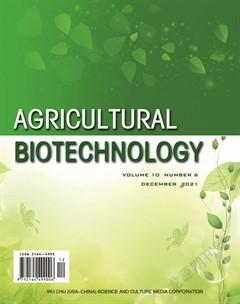Chinese Herbs as an Example for a New Class of Feed Ingredients in Aquatic Animal Diets
Yan CHEN Jingru CHEN Bing CHEN Jun MA Hai HUANG Qilin LI
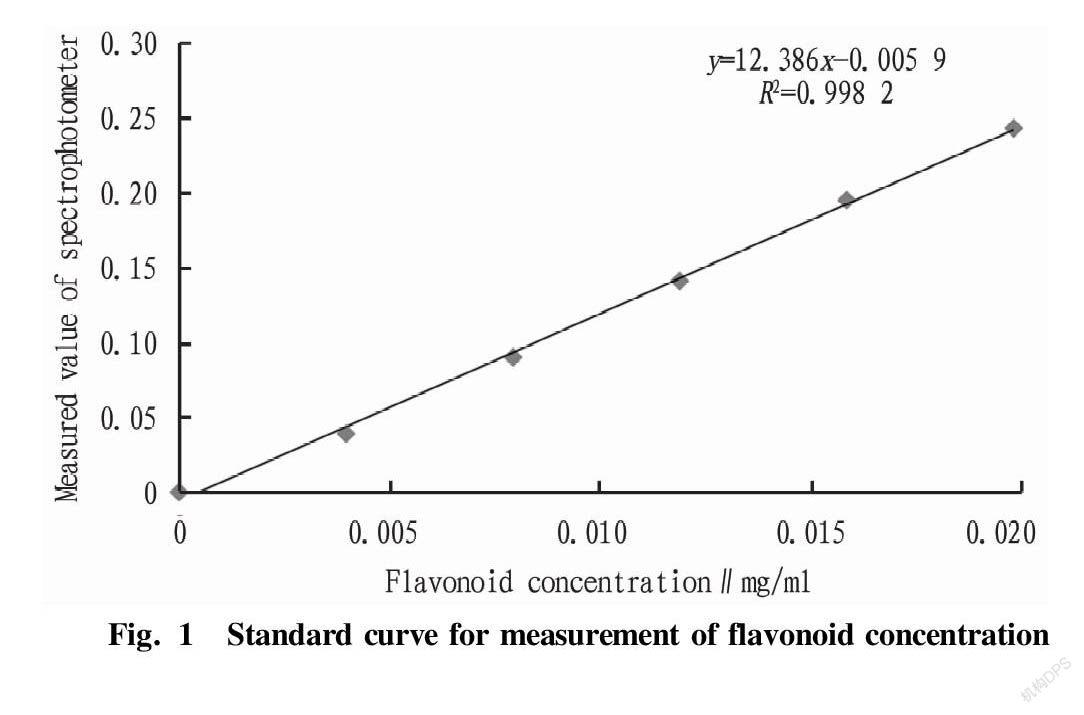

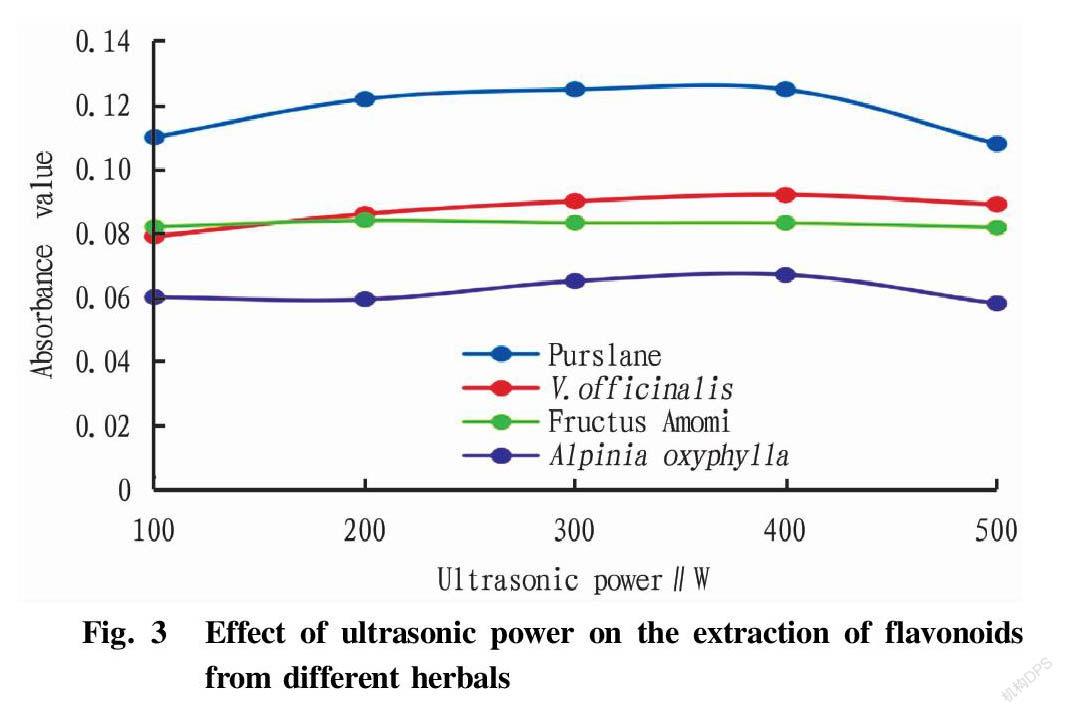
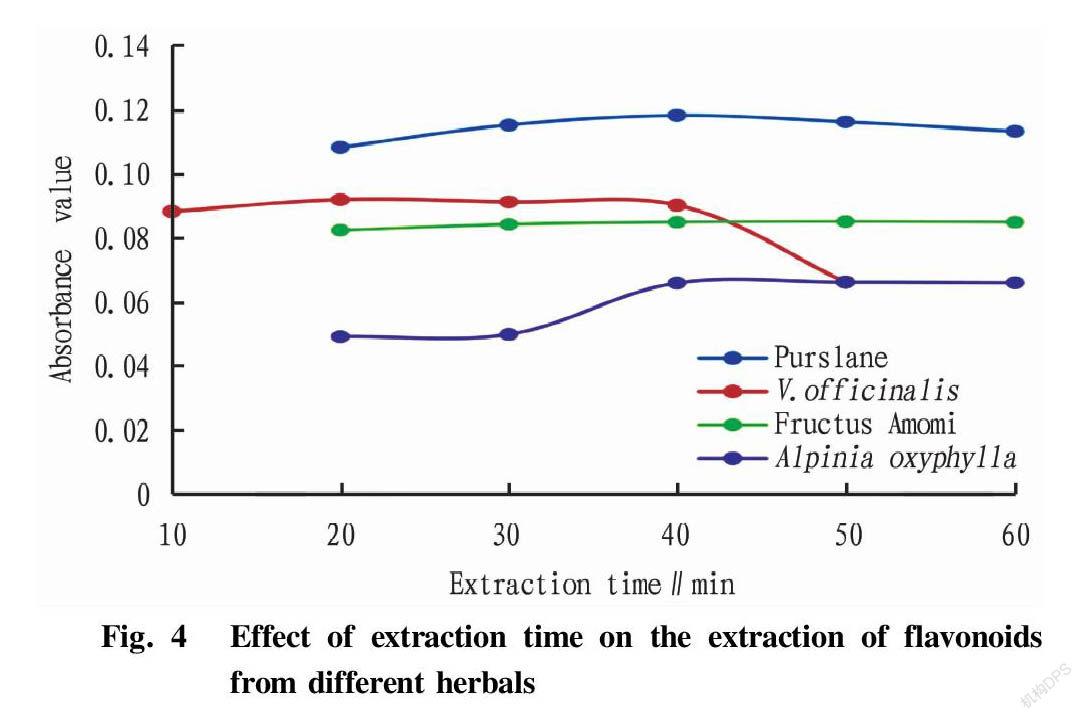


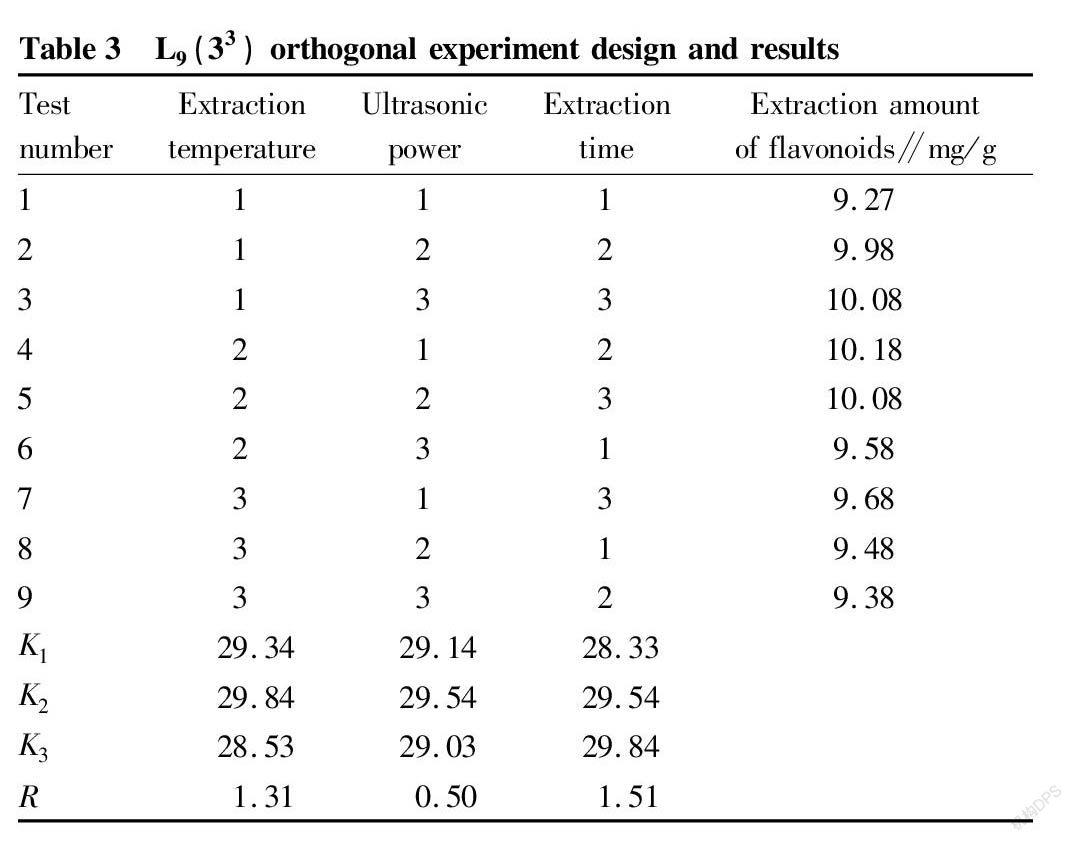


Abstract Chinese herbal flavonoids play a role in improving the health of aquatic animals and optimizing the quality of aquatic products. The efficient extraction of flavonoids is beneficial to deepening the application of flavonoids in aquatic products. To explore the optimal way of flavonoid extraction has become a hot research topic. In this study, based on temperature, ultrasonic power and extraction time, the best ways to extract flavonoids from four Chinese herbal medicines, purslane, Verbena , Fructus Amomi and Alpinia oxyphylla , were explored. Through single-factor and multi-factor optimization extraction, the most appropriate conditions for flavonoid extraction were obtained. The results showed that the best way of ultrasonic assisted extraction of flavonoids was purslane at 40 ℃, 300 W (400 W), Verbena at 70 ℃, 400W, Fructus Amomi at 50 ℃, 200 W, and A. oxyphylla at 40 ℃, 400W, and 40 min. The results of orthogonal design showed that purslane could get 13.20 mg/g at 40 ℃, 400 W and 50 min, Verbena could get 10.23 mg/g at 60 ℃, 300 W and 30 min, Fructus Amomi could get 8.18 mg/g at 50 ℃, 300 W and 60 min, and A. oxyphylla could get 7.31 mg/g at 30 ℃, 300 W and 50 min.
Key words Chinese herbal medicine; Flavonoids; Ultrasonic assisted extraction; Orthogonal test design
Received: August 31, 2021 Accepted: October 30, 2021
Supported by High-level Talents Project of Hainan Province (No.2019RC246); the Natural Science Foundation of Hainan Province (No.20163074; No.20163071); "Ichthyology" First-Class Undergraduate Course Construction Project of Hainan Province.
Yan CHEN (1983-), female, P. R. China, associate professor, devoted to research about aquatic animal nutrition and feed.
*Corresponding author.
Flavonoids have the functions of eliminating fatigue, bacteriostasis, anti-adversity[1-2], anti-virus, anti-tumor[3], anti-cancer[4], anti-aging, analgesic and anti-inflammatory, promoting body growth and reproduction[3,5-6], regulating immunity[3], protecting blood vessels, dredging microcirculation, and activating brain[7] and other organ cells. In addition, the function of enhancing stress resistance and promoting growth and reproduction is also a research hotspot in flavonoids. For example, Soybean isoflavones[1] and flavanol[2] can alleviate the adverse effects of ultraviolet rays, heavy metals and sudden temperature changes, and improve the body’s stress resistance. During the synthesis and release of luteinizing hormone (LH) and follicle stimulating hormone (FSH)[3], flavonoids can participate in the regulation to improve fecundity. Semen cuscutae flavon[6] has a positive effect on estrogen release and ovarian growth and development. Flavonoids with powerful functions can improve water quality, optimize aquatic products, nourish organism and prevent aquatic animal diseases in aquaculture, which is conducive to saving aquaculture cost and increasing economic benefits, so they have great development prospects.
After eating the diet containing mango leaf flavonoids, the survival rate of fingerlings increased, the feed coefficient decreased and the lipid peroxide of fish body decreased[10]; Flavonoids in soybean meal could promote the growth of European eel and Oreochromis aureus [11]; and daidzein could improve the sex hormone level of allogynogenetic crucian carp and enhance its reproductive capacity[12]. Flavonoids can alleviate the oxidative damage of lead stress on Tilapia[8],and improve the antioxidant capacity of all gynogenetic crucian carp[12]; formononetin in Caulis Spatholobi can kill Dactylograms in fish[13]; quercetin can inhibit Aeromonas Veronica[14]; and flavonoids can inhibit Aeromonas hydrophila , and reduce the occurrence of septicemia in aquatic animals. Soybean isoflavones can enhance the non-specific immune response of all gynogenetic crucian carp[12]; Sophora flavonoids can promote tilapia to make full use of protein and strengthen physique; and flavonoids can improve the activity of serum lysozyme and superoxide dismutase. Therefore, flavonoids can be used as feed additives to optimize the quality of aquatic products, as water quality improver to effectively inhibit and kill pathogens in water, as immune enhancer to improve the resistance of aquatic animals, and as fishery medicine to promote the healthy development of aquaculture.
Flavonoids, as an important active substance of Chinese herbal medicine, have various components and are easily soluble in organic solvents, and they have color reaction. Flavonoids of Chinese herbal with comprehensive functions are more prominent in resisting bacteria, oxidation and tumors and maintaining body health. Generally, the grinding degree of raw materials, the type of extractant, the action time, the reaction temperature, the ratio of material to liquid and the application of auxiliary technology all could affect the extraction effect of flavonoids in Chinese herbs. In the extraction of flavonoids, extraction with traditional organic solvents is low in efficiency, time-consuming and has solvent residues[9]. At present, high technology is often used to assist extraction. Especially, ultrasonic method is one of the most efficient, safe, time-saving and low temperature for sample protection method, which can protect the biological activity of flavonoids.
Purslane, Verbena officinalis , Fructus Amomi and Alpinia oxyphylla are four common Chinese herbal flavonoid ingredients in China, and all of them are rich in flavonoids. Now, research on aquaculture and nutrition of marine fish is the focus of aquaculture development in China in recent years. The optimization of extraction method for flavonoids in these four Chinese herbs can provide theoretical reference for the extraction of flavonoids. Meanwhile, flavonoids efficiently extracted from Chinese herbal medicine can be mixed in the feed for aquatic animals to play a positive role in promoting proliferation, growth and enhancing immunity. Flavonoids in water sterilization and disinfection, will be conducive to creation of a healthy culture environment, and prevention and control of aquatic animals’ diseases.
Materials and Method
Chinese herbs
Purslane, V. officinalis , Fructus Amomi and A. oxyphylla were obtained from Chinese herbal medicine store in Sanya City, Hainan Province. The dry products, which were planted in the same year, collected from June to September and well preserved, were selected in areas with little habitat difference in Hainan. Raw materials were purchased at a fixed place to ensure stable quality every time. The fresh raw materials were dried and crushed in an oven at 65 ℃. The four kinds of medicinal materials were crushed into the same particle size and sealed at -4 ℃.
Basic experimental methods
Pretreatments of materials
Purslane, Verbena , Fructus Amomi and A. oxyphylla were washed, dried in the natural shade, dried in a blast drying oven at 65 ℃ for 2 h, crushed and sieved through a 60-mesh sieve to obtained the four kinds of herbal medicine powder, which were frozen in a -4 ℃ refrigerator for later use.
Degreasing and impurity removal of Chinese herbal medicine
Proper amounts of the 4 kinds of Chinese herbal medicine dry products were taken, wrapped with 0.45 μ m, 50 mm microporous filter membrane, and put in a round bottom flask, respectively. Enough petroleum ether was added to reflux-degrease twice in serpentine Soxhlet extractors to remove impurities such as fat. Filtration was performed, and waste liquids were discarded after cooling.
The purslane, Verbena , Fructus Amomi and A. oxyphylla powder were put into drying ovens and dried at 65 ℃ for 1 h to avoid the damage of high temperature to active ingredients. The samples after impurity removal were stored in refrigerators.
Ultrasonic extraction
The four kinds of Chinese herbal medicine powder were taken out from refrigerators, and each material powder (g) and water (ml) were mixed in a ratio of 1∶40.
Then, 1 g of liquid was put into a small beaker and the flavonoids were extracted in an ultrasonic grinder. During the extraction period, ice bath was used to prevent the energy accumulation of ultrasonic wave for a long time, because the activity of flavonoids would be destroyed when the temperature was too high.
For single factor tests, 1 g of each kind of Chinese herbal medicine sample was taken, separately, and added with 40 ml of 70% ethanol to dissolve it. Extraction was carried out under different temperatures, different ultrasonic power and different time to obtain crude flavonoid extracts.
To explore the effects of single factors on the extraction rate of flavonoids, three optimal gradients were selected for each single factor, and a multi-factor optimization test was carried out as well.
Centrifugation and preparation of flavonoids extract
The prepared flavonoids were put into a centrifuge tube and centrifuged at 25 ℃, 8 000 r/min and 10 min. The supernatant was collected.
The supernatant was inverted in the circulating water vacuum pump, and 0.45 μm, 50 mm microporous membranes were used for filtration to obtain the flavonoid extract.
Identification of flavonoids
The color reaction of flavonoids was used to judge the existence of flavonoids.
The extract was put on the filter paper and put on the mouth of an ammonia bottle. The filter paper would appear yellowish. After removing the filter paper for a few minutes, the yellowish color faded, indicating the possibility of the existence of flavonoids.
A 1 ml of ethanol extract sample was added into a test tube, and added with a small amount of magnesium powder, and then several drops of concentrated hydrochloric acid was added (once). In the presence of flavonoids, the bubbles appeared purple.
Determination of flavonoids
Drawing of standard curve
① First, 10 mg of rutin standard solution was accurately weighed, dissolved with 70% ethanol solution and diluted to 100 ml. After shaking well, 0.1 mg/ml rutin standard solution was obtained.
② Then, 0, 1, 2, 3, 4 and 5 ml of standard solution were drawn into 25 ml colorimetric tubes to prepare rutin sample solutions with the concentrations of 0, 0.004, 0.008, 0.012, 0.016 and 0.02 mg/ml, respectively.
③ Next, 0.4 ml of 5% sodium nitrite solution was added into colorimetric tubes with different concentrations of rutin, respectively, and the obtained solutions were shaken well and stood for 6 min.
④ Next, 0.4 ml of 10% aluminum nitrate solution was added, followed by shaking well and allowing reaction for 6 min.
⑤ After that, 4 ml of 4% sodium hydroxide solution was sucked, and it was allowed to stand at room temperature for 15 min.
⑥ The reaction solution was put under the ultraviolet spectrophotometer, and 70% ethanol was used as the control. The absorbance value was measured at 510 nm.
⑦ The relationship curve of rutin concentration and absorbance value was drawn as the standard curve (Fig.1).
Calculation of flavonoid content
The formula for total flavonoids yield was y (mg/g)=10× c×V/M , where y is total flavonoids yield; c is mass concentration of sample solution corresponding to a certain absorbance value in the standard curve equation, mg/ml; v is volume of sample solution; and m is the mass of the sample of traditional Chinese medicine.
Analysis software
Excel 2010 was adopted for data recording and preprocessing in the experiment, and data integration, analysis and drawing of data diagrams.
Results and Analysis
Single factor optimization of extraction of Flavonoids
The effect of temperature on extraction of flavonoids from different herbals
As shown in Fig. 2, too high or too low temperature would affect the extraction number of flavonoids. Under the condition of 40 to 60 ℃, the flavonoids of purslane were well protected and the extraction amount was high, and the extraction effect was the best at 40 ℃.
Under the condition of 50-70 ℃, 300 W ultrasonic assisted extraction for 30 min, the amount of Verbena flavonoids was larger. If the temperature continued to rise, the extraction effect of flavonoids would be adversely affected. The optimum extraction temperature was 70 ℃.
For V. officinalis , under the single factor optimization scheme of 70 ℃, 400 W and 40 min, the extraction rate of flavonoids was higher.
Yan CHEN et al. Chinese Herbs as an Example for a New Class of Feed Ingredients in Aquatic Animal Diets
As shown in Fig. 2, the flavonoids could be better extracted at 40 ℃. On the contrary, when the temperature was higher than 40 ℃, the yield of flavonoids decreased. It can be seen that increasing temperature had little effect on the extraction of A. oxyphylla flavonoids.
The effect of ultrasonic power on extraction of flavonoids from different herbals
As shown in Fig. 3, the flavonoids were better extracted under the condition of 200 to 400 W, and the extraction amount was stable. The differences were small under the effect of ultrasonic power. The results showed that 300 and 400 W were the best power for extracting flavonoids from purslane.
Under the power of 300 to 500 W, the extraction efficiency of Verbena flavonoids was higher. When the power was 400 W, the amount of flavonoids was the most.
In terms of Fructus Amomi, 200 W is the most suitable for the extraction of flavonoids, not higher than 400 W which was decreased significantly.
As shown in Fig. 3, the optimum extraction temperature of 40 ℃ for 30 min increased the ultrasonic power and the amount of A. oxyphylla flavonoids. However, the promotion reached its peak at 400 W. When the power exceeded 400 W, the extraction rate of flavonoids decreased, resulting in energy consumption. The decrease of the extraction amount of flavonoids may be due to the high energy, which destroys its activity.
The effect of extraction time on extraction of flavonoids from different herbals
As shown in Fig. 4, for purslane , 70% ethanol at 40 ℃, 300 W (400 W) ultrasonic assisted extraction for 40 min can get higher extraction effect of flavonoids.
For V. officinalis , under the single factor optimization scheme of 70 ℃, 400 W and 40 min, the extraction rate of flavonoids was higher.
In the initial stage (20 min to 30 min), the growth rate of flavonoids was faster, then slowed down, and reached the maximum value at 50 min. It can be seen that the flavonoids of Fructus Amomi are time tolerant. The results of single factor optimization design showed that under the conditions of 50 ℃, 200 W ultrasonic extraction for 50 min, a higher content of flavonoids could be obtained.
As shown in Fig. 4, the extraction time of 40 min could efficiently obtain A. oxyphylla flavonoids. In the single factor optimization, the optimum extraction conditions were 40 ℃, 400 W and 40 min.
Extraction of flavonoids by multi-factor optimization
After the optimization design of temperature, ultrasonic power and extraction time, according to the effects of different conditions on the extraction rate of flavonoids, three combinations of three factors and three levels of flavonoids extraction conditions in Table 1 were obtained. The extraction of flavonoids from purslane was optimized by orthogonal design.
Multi-factor orthogonal design was used to optimize the extraction effect of flavonoids. As shown in Table 2, ultrasonic power had a greater effect on the extraction value of flavonoids from purslane, while temperature had a smaller effect on the extraction effect. The results of repeated experiments showed that the extraction amount of flavonoids from purslane could reach 13.20 mg/g under this condition.
After the optimization design of temperature, ultrasonic power and extraction time, according to the effect of different conditions on the extraction rate of flavonoids, three combinations of three factors and three levels of flavonoids extraction conditions in Table 3 were obtained. The extraction of flavonoids from V. officinalis was optimized by orthogonal design.
It can be seen from Table 3 that the extraction rate of flavonoids from V. officinalis was above 9 mg/g by the optimization design of three levels and three factors. Ultrasonic power had the least effect on the extraction of flavonoids, while Verbena flavonoids were more sensitive to temperature and time. Under the conditions of 60 ℃, 300 W and 30 min, the extraction effect of flavonoids from V. officinalis was the highest.
After synthesizing the extraction effect of various factors, the combination of temperature, ultrasonic power and extraction time was determined in Table 4. In order to optimize the extraction method of flavonoids from Fructus Amomi, orthogonal design was carried out.
As shown in Table 4, there were little differences in flavonoid content among three factors and three levels, which were about 9 mg/g. The results showed that 50 ℃, 300 W and 60 min were the best conditions for extracting flavonoids, and 8.18 mg/g flavonoids was obtained by repeated experiments.
The optimization design was shown in Table 1 and Table 5. As shown in Table 5, after optimizing the extraction method, the extraction number of flavonoids increased. The best extraction method of A. oxyphylla flavonoids was 30 ℃, 300 W, 50 min. Under these conditions, the extraction amount of flavonoids could reach 7.31 mg/g.
Discussion and Conclusions
In this study, we optimized the extraction of flavonoids from four kinds of Chinese herbal medicines, which was closely related to the reasonable selection of materials, treatment and optimization of extraction methods. ① Selection: Purslane, Verbena , Fructus Amomi and A. oxyphylla have wide sources and are easy to obtain; the four kinds of Chinese herbal medicines of the same batch with similar growth cycle and same origin were selected; the flavonoid components of the four kinds of herbs were similar; and their flavones play an important role in bacteriostasis, antioxidation and improving immunity. ② Treatment: It was the same in drying, crushing, degreasing, impurity removing, freezing, centrifugation, filtration, extraction, identification and determination of flavonoids. ③ Extraction: Single factor optimization was carried out at five levels of temperature, ultrasonic power and extraction time, and then three levels of each factor were selected for orthogonal experiment design. The single factor and multi-factor optimization design tests were conducive to explore the best extraction method.
The optimal condition of purslane was 1∶40 (g/ml) 70% ethanol, 40 ℃, 400 W, 50 min. In the study of Liang et al. [15], the ultrasonic assisted extraction of total flavonoids from purslane was carried out with 90% methanol of 1∶50 (g/ml), 80 ℃, 200 W and 30 min. However, in this present study, the amount of ethanol was saved, the solvent was cleaner, and low temperature was conducive to protecting the activity of flavonoids, but it was time-consuming and power consuming.
The optimum extraction process of flavonoids from V. officinalis was as follows: 1∶40 (g/ml) 70% ethanol, 60 ℃, 300 W, 30 min. Xing et al. [16] had the best extraction effect of total flavonoids from V. officinalis under the conditions of ultrasonic time of 40 min, liquid-solid ratio of 50∶1 and ethanol volume fraction of 60%. The optimal extraction process of the two is similar. The optimum extraction condition of flavonoids from Fructus Amomi was 1∶40 (g/ml) 70% ethanol, 50 ℃, 300 W, 60 min. Compared with 85% methanol, 73 ℃ and 101 min in Zhong’s study[17], ultrasonic was helpful to reduce the required temperature and accelerate the extraction rate. In the study of Zhu et al. [18], 70% ethanol, 1∶20 (g/ml), extraction time 90 min were adopted to obtain more A. oxyphylla flavonoids. But, in this present study, the optimum extraction conditions were 1∶40 (g/ml) 70% ethanol, 30 ℃, 300 W and 50 min. It showed that the ultrasonic assistance could improve the speed, but in this process, the more solvent would be consumed.
In this present study, although the best extraction method of flavonoids from the four kinds of Chinese herbal medicines was explored, the antibacterial and antioxidant effects of flavonoids were not studied further. Therefore, it is necessary to explore the antibacterial and antioxidant effects.
In this study, the flavonoids of purslane, Verbena , Fructus Amomi and A. oxyphylla were extracted. The optimum extraction conditions of flavonoids were as follows: 1∶40 (g/ml) 70% ethanol, purslane needed extraction at 40 ℃ and 300 W (400 W) for 40 min; Verbena needed extraction at 70 ℃ and 400 W for 40 min; Fructus Amomi needed extraction at 50 ℃ and 200 W for 50 min; and A. oxyphylla needed extraction at 40 ℃ and 400 W for 40 min. The results of orthogonal tests showed that the extraction amount of flavonoids from purslane was 13.20 mg/g at 40 ℃, 400 W and 50 min, that from V. officinalis was 10.23 mg/g at 60 ℃, 300 W and 30 min, that from Fructus Amomi was 8.18 mg/g at 50 ℃, 300 W and 60 min, and that from A. oxyphylla was 7.31 mg/g at 30 ℃, 300 W and 50 min. The amount of flavonoids from purslane was the most, while that from A. oxyphylla was the least.
References
[1] WANG CL, WANG ZL, YANG JL, et al. Research progress on synthesis, regulation, physiological and ecological functions and application of soybean isoflavones[J]. Chinese agricultural bulletin, 2019, 35(19): 34-40.
[2] ZHANG XU. Study on the stress resistance mechanism of flavonol under Pb stress based on metagenomic technology[D]. Shandong University, 2019.
[3] LI MM, JIN SY, NIU ZL, et al. Bioactivity and application of alfalfa flavonoids in ruminants[J]. China feed, 2019(13): 4-8.
[4] ZHOU LX, GUAN HQ, MA XD, et al. Effect of pistil isoflavone on proliferation and migration of lung adenocarcinoma cells[J]. Liaoning Journal of traditional Chinese medicine, 2019, 46(7): 1474-1477, 1567.
[5] ANDERSON JJB, ANTHONY MS, CLINE JM, et al. Health potential of soy isoflavones for menopausal women[J]. Public Health Nutr, 1999, 2(4): 489-504.
[6] WANG YX, MA N, ZHONG XM, et al. Effect of total flavonoids of Cuscuta chinensis on ovarian function of premature ovarian failure rats[J]. Medical review, 2019, 25(13): 2695-2699.
[7] KHAN H, MARYA, AMIN S, et al. Flavonoids as acetylcholinesterase inhibitors: Current therapeutic standing and future prospects[J].Biomed Pharmacother, 2018(101): 860-870.
[8] LIU SL. Effects of different levels of Sophora flavonoids on growth and hepatopancreas antioxidant capacity of tilapia[D]. Jimei University, 2012.
[9] CHEN GN. Extraction and antibacterial properties of flavonoids from Portulaca oleracea [D]. Xi’an University of technology, 2016.
[10] LU XW, HAO Q, CHEN YY, et al. Feed added with mango leaf flavonoids extract promotes fish growth[J]. Acta Agriculturae Engi Sinica, 2013, 29(18): 277-283.
[11] RU SG, CHEN D, WANG W. Research progress of soybean isoflavones on fish growth[J]. Journal of Ocean University of China: Natural Science Edition), 2015, 45(2): 31-36.
[12] LI YX. Safety evaluation of daidzein and cobalt chloride in cultured fish[D]. Ocean University of China, 2015.
[13] HAN J. Study on the bioactive constituents of Spatholobus suberectus against fish Dactylogyrus [D]. Northwest University of agriculture and forestry science and technology, 2011.
[14] XIANG Z. Effect of effective components of traditional Chinese medicine on virulence gene expression of Aeromonas veronica [D]. Southwest University, 2013.
[15] LIANG YN, TANG ZS, ZHANG XQ, et al. Optimization of ultrasonic assisted extraction process of total flavonoids from Portulaca oleracea L. and its antioxidant and antitumor activities[J]. Chinese agricultural bulletin, 2019, 35(4): 130-135.
[16] XING BY, CHEN TY, YANG LY, et al. Optimization of ultrasonic extraction process of total flavonoids from Verbena officinalis by response surface methodology and investigation of its antioxidant activity[J]. Food and drug, 2018, 20(1): 31-36.
[17] ZHONG XM, CHEN MZ, YAO F. Optimization of extraction technology of total flavonoids from Amomum villosum [J]. Agricultural products processing, 2018(15): 24-27.
[18] ZHU Y, YIN DH, WU Z, et al. Optimization of extraction process of total flavonoids from Alpinia oxyphylla by response surface methodology[J]. Chinese Journal of traditional Chinese medicine, 2019, 37(7): 1558-1561, 1795.
- 农业生物技术(英文版)的其它文章
- Rice Blast Resistance-associated Genes Based on Different RNA-seq Resources
- Research Progresses on QTLs for Main Grain Shape Genes in Rice
- Effects of Raising Chickens Under Moringa oleifera
- Preliminary Research on Radiation Breeding of Pteroceltis tatarinowii Maxim
- Comparison of Spring Radish Varieties with Entire Leaves
- Occurrence and Chemical Control Techniques of Rice Black-streaked Dwarf Disease in Rongshui County

